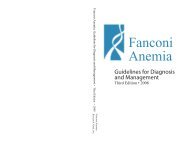FA Family Newsletter - Fanconi Anemia Research Fund
FA Family Newsletter - Fanconi Anemia Research Fund
FA Family Newsletter - Fanconi Anemia Research Fund
- No tags were found...
You also want an ePaper? Increase the reach of your titles
YUMPU automatically turns print PDFs into web optimized ePapers that Google loves.
DNA Testing for <strong>FA</strong> Before PregnancyScience News From the <strong>Family</strong> MeetingCertified geneticscounselor Heather Zierhut,MS, gave Camp Sunshineattendees an overview ofpreimplantation geneticdiagnosis (PGD). PGDoffers families the option oftesting for <strong>Fanconi</strong> anemiaand for human leukocyteantigens status in an earlyembryo before implantation.Readers can consult the October 2010 <strong>FA</strong> <strong>Family</strong><strong>Newsletter</strong> for detailed information on the steps involved inthis process.The Reproductive Genetics Institute of Chicago,Illinois, has helped 17 families at risk for <strong>FA</strong> to try toexpand their families. These families have gone through51 PGD cycles (average is three per family), resultingin the births of six healthy children. The chance thatany one PGD attempt will result in the birth of a childis 12%. PGD is expensive, averaging approximately$20,000 per cycle. Most insurance companies will notcover PGD.Zierhut discussed the physical and emotionalimplications of undergoing PGD. Interviews with14 women who had undergone PGD elicited bothpositive and negative emotions: women felt in control,empowered and hopeful, but also experienced anxietywhile anticipating results, and extreme distress when acycle failed. It was suggested that couples consider inadvance what they will do with fertilized eggs that arenot needed when the process ends. Zierhut cautionedthat PGD can negatively affect future pregnancies and,on rare occasion, be life-threatening to the mother.Excellent Transplant Outcomes Continue atCharité Hospital, BerlinOver more than a decade,Wolfram Ebell, MD,Charité Children’s Hospital,Berlin, has transplanted27 <strong>Fanconi</strong> anemiapatients with protocolsusing oral busulfan in acumulative dose of 2 mg/kg instead of radiation inthe conditioning regimen.None of these patientshas experienced organ toxicity clearly attributed tothe busulfan. Dr. Ebell stated that he uses half of thebusulfan dosage currently given in a multi-center, USbasedstudy, which could explain the lack of toxicity.Alternate donor transplants continue to improve atCharité Children’s Hospital (see <strong>FA</strong> <strong>Family</strong> <strong>Newsletter</strong>#49 for information on recent protocols and outcomesat this center). All nine patients with alternate donorson the present protocol, called GE<strong>FA</strong>03, survive, withonly one experiencing grade 1 graft-versus-host disease.One patient on GE<strong>FA</strong>03 relapsed with his originalclonal abnormality. This patient was given a mild dose offludarabine, Cytoxan and ARA-C, and a stem cell boostfrom his original donor, and is now disease-free.At his center, Dr. Ebell finds nosurvival difference betweenpatients with matched siblingdonors and those with alternatedonors.Dr. Ebell noted that a large number of <strong>FA</strong> patients,often with androgen support, do not undergotransplant. This group still survives longer thanpatients who have needed to go to transplant. Withimprovements in transplant outcomes, this couldchange. At his center, Dr. Ebell finds no survivaldifference between patients with matched sibling donorsand those with alternate donors.8 <strong>Family</strong> <strong>Newsletter</strong> #50
















